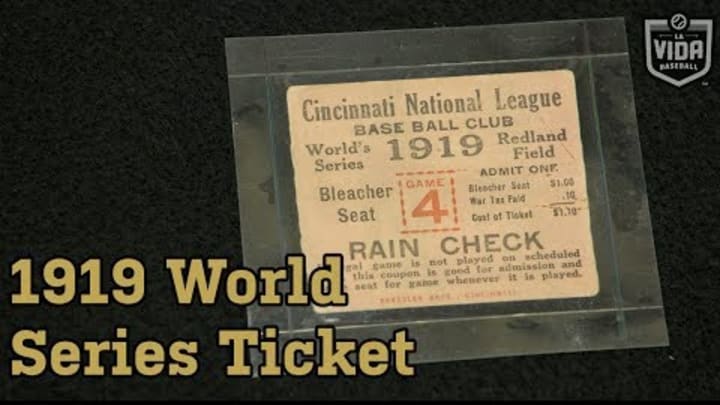World Series Artifacts: The significance of a 1919 Ticket Stub
By Adrian Burgos

When was the first time a Latino played in the World Series? Was it when Roberto Clemente starred with the Pittsburgh Pirates in the 1971 World Series win over the Baltimore Orioles? Or was it when Luis Aparicio and the Go-Go Sox faced off versus the Los Angeles Dodgers in the 1959 World Series?
That bit of postseason history was made by Cincinnati Reds pitcher Adolfo “Dolf” Luque when he threw a scoreless inning in relief in a Game 3 loss to the Chicago White Sox in the 1919 World Series.
Latino participation in the World Series thus occurred much earlier than most baseball fans realize, much like the overall history of Latino participation in the major leagues.
1919: An Unforgettable Series
Baseball fans remember the 1919 World Series in which Luque appeared for an altogether different reason.
The 1919 World Series is known for the Black Sox scandal. Eight White Sox players were accused of fixing the World Series. The story of what transpired during the 1919 series has been retold by not just historians but also Hollywood screenwriters and novelists, most notably in “Eight Men Out” and “Field of Dreams.”
The 1919 World Series changed baseball. The scandal that arose from the accusations against the White Sox players and the trial that followed led to the hiring of the first Major League commissioner.
But for Latinos, the 1919 series has additional significance.
When Luque took the mound in the eighth inning of Game 3, the Cuba-native initiated the participation of Latinos in the World Series. He made another appearance in Game 7, pitching four shutout innings surrendering just one hit while striking out five in a 4-1 loss to Chicago.
The Reds won the best-of-nine format World Series in 1919, making Luque the first Latino to win a World Series ring.
The Cuban was outstanding in his two appearances, finishing the series with five shutout innings in which he gave up just one hit and no walks while striking out six.
Second Time Just as Good
Fourteen years later Luque appeared in another World Series in 1933 with New York Giants.
The 42-year-old pitcher proved masterful. Luque took over in the sixth inning of Game 5 after the Washington Senators tied the score 3-3.
Luque retired Luke Sewell to quash the Senators rally in the sixth. The Giants made Luque a winner when they finally scored a run in the tenth inning. The Cuban had pitched four shutout innings in the Game 5 that clinched the World Series championship.
Appearing in two series fourteen years apart, Luque performed at his best in the World Series. He pitched nine-and-a-third shutout innings in three appearances during those two series. He struck out 11 while walking two and just giving up three hits. He demonstrated a level of domination that would please any pitcher: one win, a 0.00 ERA, 0.536 WHIP, and 5.50 strikeout-walk ratio.
In so doing, Luque made another bit of baseball history as the first Latino player to be a member of two World Series champions.